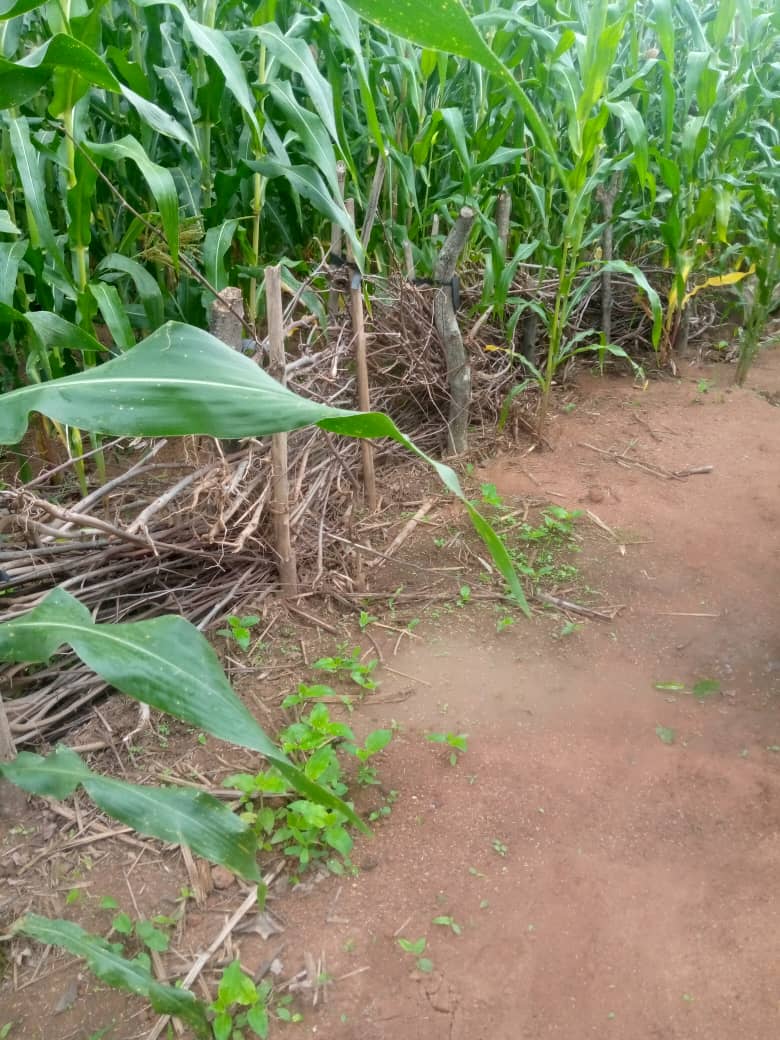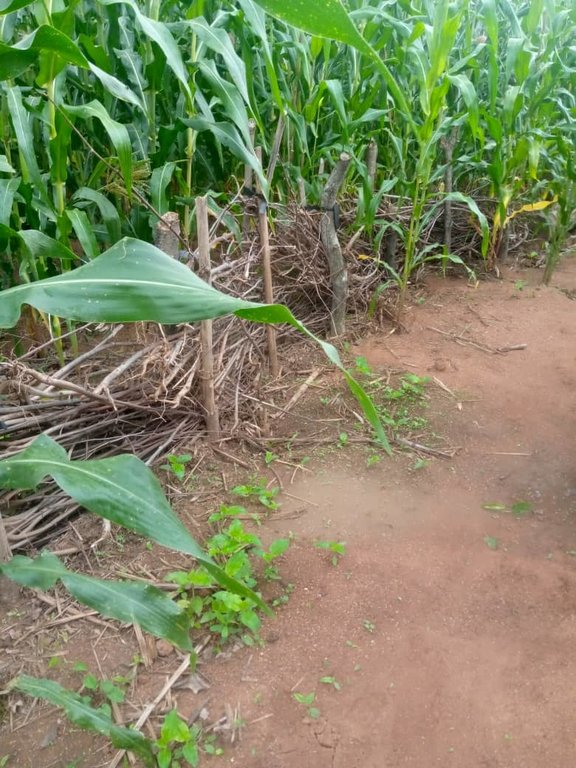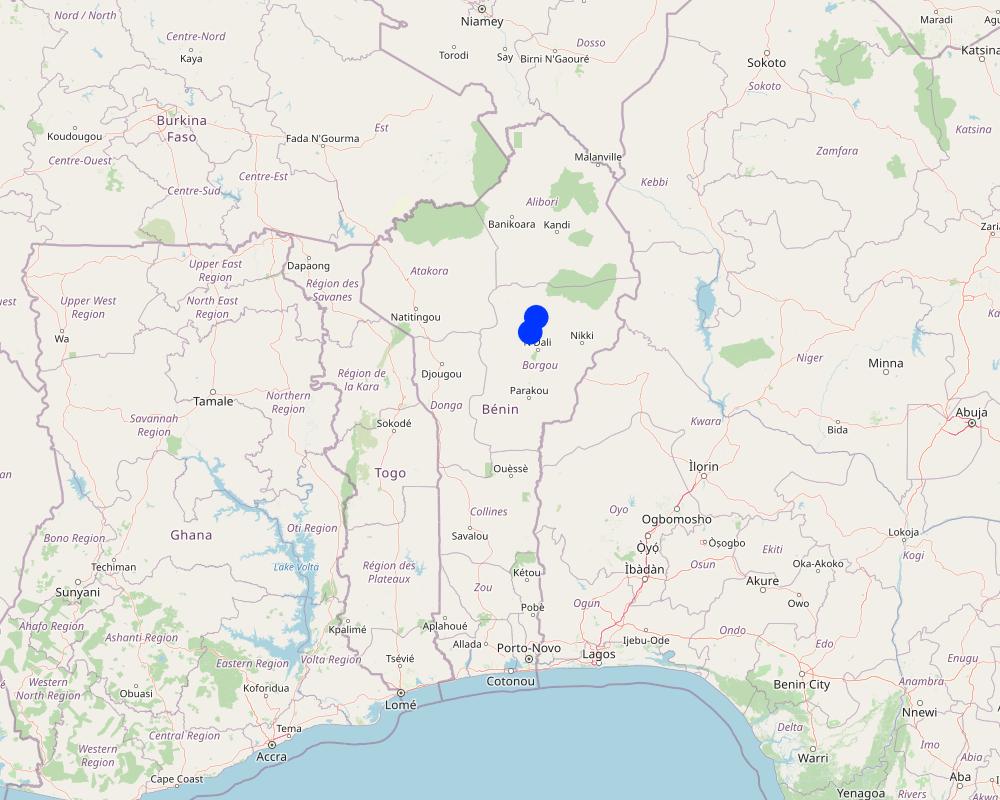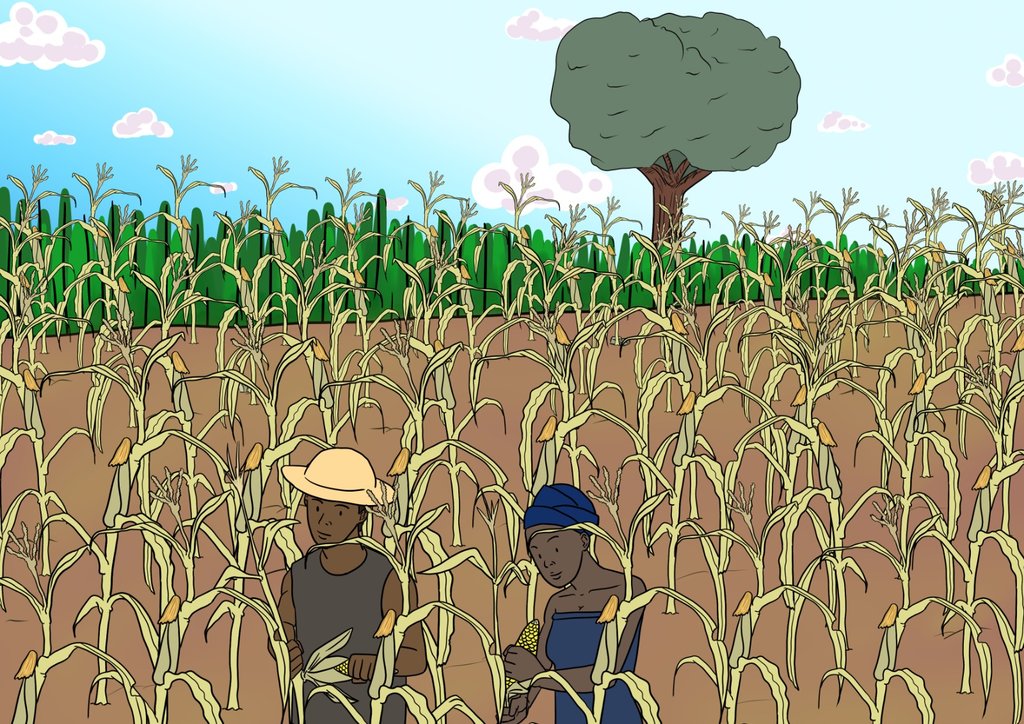Short-Cycle Varieties of Maize [Benin]
- Creation:
- Update:
- Compiler: Gatien AGBOKOUN CHRISTOPHE
- Editors: Siagbé Golli, Abdoul Karim MIEN, DOSSOU-YOVO bernardin, Bona Ibouratou DAFIA, Oscar Assa KINDEMIN, Tabitha Nekesa, Ahmadou Gaye
- Reviewers: Sally Bunning, Rima Mekdaschi Studer, William Critchley
Carder gbérénou
technologies_6686 - Benin
View sections
Expand all Collapse all1. General information
1.2 Contact details of resource persons and institutions involved in the assessment and documentation of the Technology
Key resource person(s)
SLM specialist:
TAOUFIK Alassane
CAPID ONG
Benin
SLM specialist:
ABDOUL Kahar Mama
CAPID ONG
Benin
land user:
ZAKARI Mossa
CAPID ONG
Benin
land user:
ALASSANE Fouseni
CAPID ONG
Benin
Name of project which facilitated the documentation/ evaluation of the Technology (if relevant)
Soil protection and rehabilitation for food security (ProSo(i)l)Name of the institution(s) which facilitated the documentation/ evaluation of the Technology (if relevant)
GIZ Bénin (GIZ Bénin) - Benin1.3 Conditions regarding the use of data documented through WOCAT
The compiler and key resource person(s) accept the conditions regarding the use of data documented through WOCAT:
Yes
1.4 Declaration on sustainability of the described Technology
Is the Technology described here problematic with regard to land degradation, so that it cannot be declared a sustainable land management technology?
No
2. Description of the SLM Technology
2.1 Short description of the Technology
Definition of the Technology:
Short-cycle varieties are crops whose products mature in no more than three months. These crops, which include certain maize varieties, are grown to adapt to climatic hazards, especially in areas with irregular rainfall cycles.
2.2 Detailed description of the Technology
Description:
The utilization of short-cycle varieties is one way of adapting to climate change. Maize is a good example. For one hectare, a quantity of 20 kg of seeds is required. The planting configuration includes sowing at a distance of 40 cm within the rows and 80 cm between the rows, with a seeding depth of 3 to 5 cm, at a rate of 2 seeds per hole.
Short-cycle varieties are used to adapt to climatic hazards, especially in areas with irregular rainfall cycles. The process of planting and maintenance comprises a series of tasks, including soil preparation, seed purchase, ploughing, maize seeding occurring two to four weeks before pigeon peas are sown. Subsequent steps involve weeding and hoeing/ridging if necessary.
Short-cycle varieties can yield in approximately 45 days, with a maximum timeframe of 80-90 days. In Benin, there is a list of short-cycle maize varieties, including BEMA14 J-07, BEMA14 J-08, BEMA14 J-15, BEMA00 J-20, BEMA14 B-09, BEMA14 B-10, EV DT 97 STR W, DMR ESR W BENIN, BEMA 94 B15, 2000 SYN EE W, and others.
The preference for early varieties among producers stems from their ability to expedite product maturation, a crucial factor in the current context characterized by climate change. For women in particular, short-cycle maize is a significant source of income. During these periods, they sell it fresh, cooked, or grilled. However, it should be noted that that each of these varieties comes with its own maintenance and input requirements, as well as their own production costs.
2.3 Photos of the Technology
2.5 Country/ region/ locations where the Technology has been applied and which are covered by this assessment
Country:
Benin
Region/ State/ Province:
Borgou
Further specification of location:
Bembéréké
Specify the spread of the Technology:
- evenly spread over an area
Is/are the technology site(s) located in a permanently protected area?
No
Map
×2.6 Date of implementation
If precise year is not known, indicate approximate date:
- 10-50 years ago
2.7 Introduction of the Technology
Specify how the Technology was introduced:
- through projects/ external interventions
Comments (type of project, etc.):
Short-cycle varieties, including maize, were introduced by the Government through its decentralized bodies.
3. Classification of the SLM Technology
3.1 Main purpose(s) of the Technology
- improve production
- reduce risk of disasters
- adapt to climate change/ extremes and its impacts
- create beneficial economic impact
3.2 Current land use type(s) where the Technology is applied
Land use mixed within the same land unit:
No

Cropland
- Annual cropping
Annual cropping - Specify crops:
- cereals - maize
Number of growing seasons per year:
- 2
Specify:
With short-cycle varieties, producers can transition to cultivating soybeans or cowpeas after harvesting maize.
Is crop rotation practiced?
Yes
If yes, specify:
Soybeans or cowpeas
3.3 Has land use changed due to the implementation of the Technology?
Has land use changed due to the implementation of the Technology?
- Yes (Please fill out the questions below with regard to the land use before implementation of the Technology)
Land use mixed within the same land unit:
No

Cropland
- Annual cropping
Annual cropping - Specify crops:
- cereals - maize
Is crop rotation practiced?
Yes
If yes, specify:
Rotation typically involves cotton and follows a seasonal pattern. Nevertheless, within the same season, there exists a rotation cycle involving maize, soybeans, and cowpeas.
3.4 Water supply
Water supply for the land on which the Technology is applied:
- rainfed
3.5 SLM group to which the Technology belongs
- Climate change adaptation measures
3.6 SLM measures comprising the Technology

management measures
- M1: Change of land use type
- M4: Major change in timing of activities
3.7 Main types of land degradation addressed by the Technology

water degradation
- Ha: aridification
3.8 Prevention, reduction, or restoration of land degradation
Specify the goal of the Technology with regard to land degradation:
- not applicable
Comments:
Adapting to climate change
4. Technical specifications, implementation activities, inputs, and costs
4.1 Technical drawing of the Technology
Technical specifications (related to technical drawing):
For successful seed germination, a minimum rainfall of 20 mm is essential before sowing. Sowing can be performed either manually or mechanically. The optimal sowing window falls between May 15 and June 15, following sufficient rainfall to support robust seed germination. The recommended seed quantity is 20 kg per hectare.
In terms of sowing density, for extra-early varieties (70-84 days), a requirement of 83,000 plants per hectare is advised, with spacing options of 0.80m x 0.30m or 0.75m x 0.32m. Early varieties (95-94 days) should be sown at a density of 6,550 plants per hectare, using spacing configurations of 0.80m x 0.38m or 0.75m x 0.40m.
4.2 General information regarding the calculation of inputs and costs
Specify how costs and inputs were calculated:
- per Technology area
Indicate size and area unit:
1 ha
other/ national currency (specify):
CFA F
4.3 Establishment activities
| Activity | Timing (season) | |
|---|---|---|
| 1. | Soil preparation (clearing) | March-April |
| 2. | Plowing | April-May |
| 3. | Seeding | May-June |
| 4. | Harvest | July |
4.4 Costs and inputs needed for establishment
| Specify input | Unit | Quantity | Costs per Unit | Total costs per input | % of costs borne by land users | |
|---|---|---|---|---|---|---|
| Labour | Soil preparation (clearing) | ha | 1.0 | 17000.0 | 17000.0 | 100.0 |
| Labour | Plowing | ha | 1.0 | 30000.0 | 30000.0 | 100.0 |
| Labour | Seeding | ha | 1.0 | 15000.0 | 15000.0 | 100.0 |
| Plant material | Seeds | ha | 20.0 | 300.0 | 6000.0 | 100.0 |
| Total costs for establishment of the Technology | 68000.0 | |||||
| Total costs for establishment of the Technology in USD | 68000.0 | |||||
4.5 Maintenance/ recurrent activities
| Activity | Timing/ frequency | |
|---|---|---|
| 1. | Weeding | June |
| 2. | Hoeing and ridging | June |
| 3. | Fertilizer spreading | June |
4.6 Costs and inputs needed for maintenance/ recurrent activities (per year)
| Specify input | Unit | Quantity | Costs per Unit | Total costs per input | % of costs borne by land users | |
|---|---|---|---|---|---|---|
| Labour | Weeding | ha | 1.0 | 15000.0 | 15000.0 | 100.0 |
| Labour | Hoeing and ridging | ha | 1.0 | 200000.0 | 200000.0 | 100.0 |
| Labour | Fertilizer spreading | Bag | 4.0 | 2500.0 | 10000.0 | 100.0 |
| Fertilizers and biocides | NPK | Bag | 3.0 | 16000.0 | 48000.0 | 100.0 |
| Fertilizers and biocides | Urea | Bag | 1.0 | 16000.0 | 16000.0 | 100.0 |
| Total costs for maintenance of the Technology | 289000.0 | |||||
| Total costs for maintenance of the Technology in USD | 289000.0 | |||||
4.7 Most important factors affecting the costs
Describe the most determinate factors affecting the costs:
Labourers for ploughing and weeding
5. Natural and human environment
5.1 Climate
Annual rainfall
- < 250 mm
- 251-500 mm
- 501-750 mm
- 751-1,000 mm
- 1,001-1,500 mm
- 1,501-2,000 mm
- 2,001-3,000 mm
- 3,001-4,000 mm
- > 4,000 mm
Specify average annual rainfall (if known), in mm:
1023.00
Specifications/ comments on rainfall:
Bembèrèkè's Sudano-Guinean climate is characterized by an extended rainy season (April to October) and a prolonged dry season (November to March).
Agro-climatic zone
- sub-humid
5.2 Topography
Slopes on average:
- flat (0-2%)
- gentle (3-5%)
- moderate (6-10%)
- rolling (11-15%)
- hilly (16-30%)
- steep (31-60%)
- very steep (>60%)
Landforms:
- plateau/plains
- ridges
- mountain slopes
- hill slopes
- footslopes
- valley floors
Altitudinal zone:
- 0-100 m a.s.l.
- 101-500 m a.s.l.
- 501-1,000 m a.s.l.
- 1,001-1,500 m a.s.l.
- 1,501-2,000 m a.s.l.
- 2,001-2,500 m a.s.l.
- 2,501-3,000 m a.s.l.
- 3,001-4,000 m a.s.l.
- > 4,000 m a.s.l.
Indicate if the Technology is specifically applied in:
- not relevant
5.3 Soils
Soil depth on average:
- very shallow (0-20 cm)
- shallow (21-50 cm)
- moderately deep (51-80 cm)
- deep (81-120 cm)
- very deep (> 120 cm)
Soil texture (topsoil):
- coarse/ light (sandy)
- medium (loamy, silty)
Soil texture (> 20 cm below surface):
- coarse/ light (sandy)
- medium (loamy, silty)
Topsoil organic matter:
- low (<1%)
5.4 Water availability and quality
Ground water table:
5-50 m
Availability of surface water:
medium
Water quality (untreated):
good drinking water
Water quality refers to:
ground water
Is water salinity a problem?
No
Is flooding of the area occurring?
No
5.5 Biodiversity
Species diversity:
- medium
Habitat diversity:
- medium
5.6 Characteristics of land users applying the Technology
Sedentary or nomadic:
- Sedentary
Market orientation of production system:
- commercial/ market
Off-farm income:
- less than 10% of all income
Relative level of wealth:
- poor
- average
Individuals or groups:
- groups/ community
Level of mechanization:
- animal traction
- mechanized/ motorized
Gender:
- women
- men
Age of land users:
- youth
- middle-aged
5.7 Average area of land used by land users applying the Technology
- < 0.5 ha
- 0.5-1 ha
- 1-2 ha
- 2-5 ha
- 5-15 ha
- 15-50 ha
- 50-100 ha
- 100-500 ha
- 500-1,000 ha
- 1,000-10,000 ha
- > 10,000 ha
Is this considered small-, medium- or large-scale (referring to local context)?
- small-scale
- medium-scale
5.8 Land ownership, land use rights, and water use rights
Land ownership:
- communal/ village
Land use rights:
- communal (organized)
Water use rights:
- communal (organized)
Are land use rights based on a traditional legal system?
Yes
Specify:
The lands belong to family groups.
5.9 Access to services and infrastructure
health:
- poor
- moderate
- good
education:
- poor
- moderate
- good
technical assistance:
- poor
- moderate
- good
employment (e.g. off-farm):
- poor
- moderate
- good
markets:
- poor
- moderate
- good
energy:
- poor
- moderate
- good
roads and transport:
- poor
- moderate
- good
drinking water and sanitation:
- poor
- moderate
- good
financial services:
- poor
- moderate
- good
6. Impacts and concluding statements
6.1 On-site impacts the Technology has shown
Socio-economic impacts
Production
crop production
risk of production failure
product diversity
Income and costs
expenses on agricultural inputs
farm income
Comments/ specify:
Thanks to short-cycle varieties, producers are able to harvest several crops.
6.3 Exposure and sensitivity of the Technology to gradual climate change and climate-related extremes/ disasters (as perceived by land users)
Gradual climate change
Gradual climate change
| Season | increase or decrease | How does the Technology cope with it? | |
|---|---|---|---|
| annual temperature | increase | moderately | |
| seasonal temperature | wet/ rainy season | decrease | moderately |
| annual rainfall | decrease | moderately | |
| seasonal rainfall | wet/ rainy season | decrease | well |
6.4 Cost-benefit analysis
How do the benefits compare with the establishment costs (from land users’ perspective)?
Short-term returns:
very positive
Long-term returns:
positive
How do the benefits compare with the maintenance/ recurrent costs (from land users' perspective)?
Short-term returns:
very positive
Long-term returns:
positive
6.5 Adoption of the Technology
- > 50%
Of all those who have adopted the Technology, how many did so spontaneously, i.e. without receiving any material incentives/ payments?
- 11-50%
Comments:
These are producers who sought out seeds even before ProSOL made the first seeds available to them.
6.6 Adaptation
Has the Technology been modified recently to adapt to changing conditions?
No
6.7 Strengths/ advantages/ opportunities of the Technology
| Strengths/ advantages/ opportunities in the land user’s view |
|---|
| Increased crop yields |
| Rapid maturation of agricultural products |
| Possibility of crop succession on the same plot |
| Strengths/ advantages/ opportunities in the compiler’s or other key resource person’s view |
|---|
| Adaptability to climatic contingencies |
| Opportunity to diversify agricultural income |
6.8 Weaknesses/ disadvantages/ risks of the Technology and ways of overcoming them
| Weaknesses/ disadvantages/ risks in the land user’s view | How can they be overcome? |
|---|---|
| High cost of seeds | Promote the emergence of seed companies |
| Labour-intensive requirements | Combine manpower (employed and family) for synergistic action |
| Difficulties in storing until the desired time for marketing... | Sell to women who then sell them boiled or grilled |
| Weaknesses/ disadvantages/ risks in the compiler’s or other key resource person’s view | How can they be overcome? |
|---|---|
| Input requirements | Utilization of organic fertilizers and crop residues to reduce production costs |
7. References and links
7.1 Methods/ sources of information
- field visits, field surveys
2
- interviews with land users
2
- interviews with SLM specialists/ experts
2
- compilation from reports and other existing documentation
4
When were the data compiled (in the field)?
08/02/2023
7.2 References to available publications
Title, author, year, ISBN:
Deutsche Gesellschaft für Internationale Zusammenarbeit (GIZ) GmbH, 2018, Compendium de fiches techniques du formateur,
Title, author, year, ISBN:
ACMA 2, 2019, Fiche Technique : Itinéraire technique du maïs
Available from where? Costs?
https://ifdc.org/wp-content/uploads/2019/07/FICHE-TECHNIQUE-1-ITINERAIRE-TECHNIQUE-DU-MAI%CC%88S-MAIZE-TECHNICAL-ITINERARY.pdf
Title, author, year, ISBN:
Deutsche Gesellschaft für Internationale Zusammenarbeit (GIZ) GmbH, 2018, Mesures de Gestion Durable des Terres (GDT) et d’Adaptation au Changement Climatique (ACC) : Boîte à images pour l’animation des séances de formation avec les agriculteurs
7.3 Links to relevant online information
Title/ description:
FICHE TECHNIQUE SYNTHETIQUE POUR LA PRODUCTION DU MAÏS JAUNE (Zea mays L.)
URL:
https://gbios-uac.org/wp-content/uploads/2019/03/FICHE-TECHNIQUE-SYNTHETIQUE-POUR-LA-PRODUCTION-DU-MA%C3%8FS-JAUNE-Zea-mays-L..pdf
Links and modules
Expand all Collapse allLinks
No links
Modules
No modules





